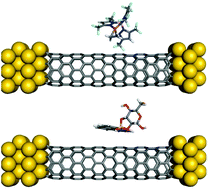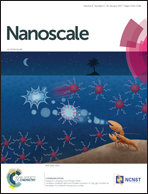Selective sensing of ethylene and glucose using carbon-nanotube-based sensors: an ab initio investigation†
Abstract
Functionalized carbon nanotubes have great potential for nanoscale sensing applications, yet many aspects of their sensing mechanisms are not understood. Here, two paradigmatic sensor configurations for detection of biologically important molecules are investigated through ab initio calculations: a non-covalently functionalized nanotube for glucose detection and a covalently functionalized nanotube for ethylene detection. Glucose and ethylene control key life processes of humans and plants, respectively, despite of their structural and chemical simplicity. The sensors’ electrical conductance and transmission coefficients are evaluated at the full density-functional theory level via the non-equilibrium Green's function method. We also investigate the effects of the density of the receptors, the band gaps of the nanotubes, the source–drain voltages, and the atomic modification of the receptor on detection sensitivities. A clear atomistic picture emerges about the mechanisms involved in glucose and ethylene sensing. While semiconducting nanotubes exhibit good sensitivities in both cases, the current through metallic nanotubes is only weakly affected by analyte attachment. These quantitative results could guide the design of improved sensors.



 Please wait while we load your content...
Please wait while we load your content...